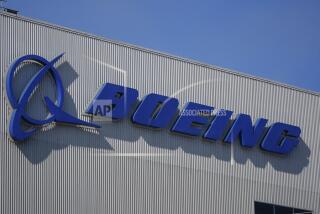Boeing Looks to Build 737s in Long Beach
- Share via
Boeing Co. disclosed Tuesday that it has a tentative plan to build 737 jetliners in Long Beach, raising the potential for thousands of new jobs and offering a turning point for the long troubled Douglas plant.
The aerospace giant stopped well short of committing to the project, but Boeing officials said they would not have announced the prospective Long Beach expansion without a high level of confidence that it would go forward.
The first step involves the modest decision to transfer 10 partially completed 737 jetliners to Long Beach for interior work and refurbishment. Initially, Seattle-based Boeing would assign about 200 workers to the job, including recalling about 80 workers who are on furlough.
With its Puget Sound plants suffering for nearly a year with serious production breakdowns, Boeing said it is hoping to tap the unused capability of the sprawling 400-acre Long Beach plant.
Boeing has fallen behind schedule on 737 deliveries and is incurring massive overtime at its plant in Renton, Wash., to catch up. Last year, Boeing said it would record $2.6 billion in charges against profit because of the foul-ups on its 737 and 757 production lines.
Boeing has consistently overestimated its ability to bounce back from those problems. The Long Beach plan appears to signal that the company has finally decided that it needs additional production capacity outside Puget Sound. Boeing officials added that they are not considering any alternative site for the program.
If the firm does create a new final assembly line for aircraft in Long Beach, it would mark the first time it has built Boeing commercial jets outside of Washington.
Fred Mitchell, Boeing executive vice president for airplane production, said the tentative Long Beach project represents an effort to “better balance our workload and meet customers’ commitments.” He cited the firm’s hope to build up the work force at the Douglas plant.
Boeing said in a statement that it is “considering” setting up a 737 assembly line in Long Beach. Mitchell said the firm is “reviewing the business case for establishing” the line.
Aerospace analysts praised Boeing’s Long Beach plan, saying it appears to be a sound response to long-term capacity problems in Puget Sound.
“Boeing has had enough difficulty in achieving a smooth production system that they should be interested in any solutions,” said BT Alex.Brown aerospace analyst Wolfgang Demisch. “It is not unreasonable to do something to maintain substantial visibility in Los Angeles, politically and from a labor force standpoint.”
Indeed, state officials and labor leaders also praised the plan. Bruce Lee, an aerospace consultant and former United Auto Workers union international representative, said he is convinced Boeing is serious about putting major investments into Long Beach.
Nonetheless, Boeing’s announcement is highly unusual because corporations almost always wait until a final decision is made before announcing that they will undertake projects with such major economic consequences.
Boeing managers, who asked not to be named, acknowledged the announcement was extraordinary, but said the plan involves a number of steps that they could not commit to at the outset. They also noted it will involve two separate unions representing workers, the International Assn. of Machinists in Seattle and the UAW in Long Beach.
So far, the two unions have been on relatively good terms. Bill Johnson, president of Machinists Local 751, which represents Boeing’s vast Seattle hourly work force, has said that he does not intend to attempt to block any Boeing efforts to aid Long Beach, so long as it does not undermine his union.
Boeing officials, speaking on the condition of anonymity, said their plan would not involve the loss of any jobs in Seattle.
Boeing officials declined to discuss how much investment would be required to start building aircraft in Long Beach or how many jobs might be created.
But generally, the massive steel structures used to assemble aircraft, known as jig and fixtures, typically cost tens of millions of dollars, not including any facilities improvements that might be necessary in Long Beach. The complex received little updating during its three decades of ownership by McDonnell Douglas Corp., which was acquired by Boeing in 1997. Virtually all commercial aircraft assembly lines employ at least a few thousand workers; high-volume lines can employ tens of thousands of workers.
Boeing’s plan marks a jolting change in direction from just two months ago, when the firm said it would eliminate 3,000 jobs at the Long Beach plant through next year, resulting from the elimination of the MD-80 and MD-90 jetliners. Boeing said at the time that it had no plans to transfer any work from Seattle to offset the cutbacks.
The cutbacks were a big letdown to workers and state economic development officials, who had been led to believe that Boeing would put additional production work in Long Beach to soften the blow of phasing out the MD-80 and MD-90.
Boeing is still reviewing the future of the MD-11 jetliner, which employs several thousand additional workers in Long Beach. Boeing has said it must sell more of the jets if the program is to survive.
It remains unclear how much of the future Long Beach layoffs might be offset by the 737 plan, but an internal Boeing memorandum lays out a fairly ambitious agenda for expanding operations at the plant.
In the modest first phase, Boeing would convert five 737 aircraft used in flight testing to passenger configuration and conduct “finishing” on five additional planes, including installing their interiors.
If the small-scale refurbishment work goes well, the firm would move to establishing a permanent assembly line for the next-generation 737 aircraft.
The next-generation 737 includes a family of jets, designated the 737-600, 737-700, 737-800 and 737-900. All but the 737-900 are either in development or in initial production. The next-generation series ranges in size from carrying 110 to 189 passengers.
Under the tentative plan, the Long Beach plant would specialize in building unusual or unique configurations of these series, such as the 737s sold as business jets and the 737s sold as convertible freighters.
More to Read
Inside the business of entertainment
The Wide Shot brings you news, analysis and insights on everything from streaming wars to production — and what it all means for the future.
You may occasionally receive promotional content from the Los Angeles Times.










